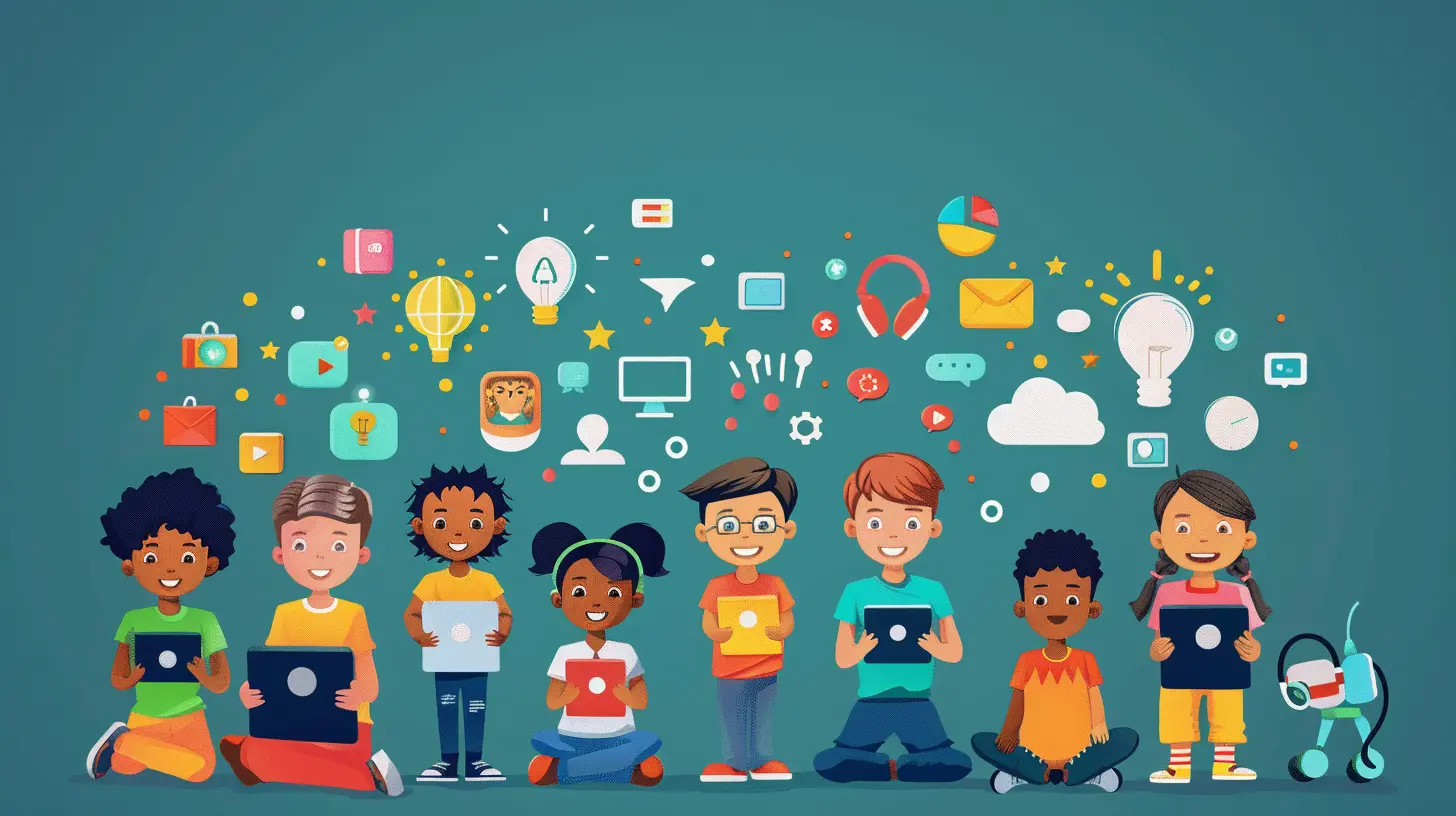Teaching Digital Citizenship Alongside STEM Skills
16 March 2025
In today's tech-driven world, where kids are picking up tablets before they can even walk, it's become increasingly important to ensure young learners aren't just tech-savvy, but also tech-wise. Enter the concept of digital citizenship. While STEM (Science, Technology, Engineering, and Mathematics) skills are crucial for equipping students with the tools they need to succeed in the future, teaching digital citizenship alongside STEM is like giving them a moral compass for navigating the digital landscape.
But how do educators go about integrating both? How can we ensure that our kids not only excel in coding and robotics but also understand the ethics of sharing online, the importance of privacy, and the responsibility of communication in the digital world?
Let’s dive into why both digital citizenship and STEM skills are essential and how they can (and should) be taught together.

Understanding STEM Education
Before we get into digital citizenship, it’s important to lay out what STEM education is all about. STEM represents four key areas of learning:- Science
- Technology
- Engineering
- Mathematics
STEM isn't just about teaching these subjects independently. It's about blending them to foster critical thinking, creativity, and problem-solving skills. It’s a holistic approach that gets students to think like innovators, preparing them for careers in fields like robotics, computer programming, and biotechnology.
At its core, STEM education pushes students to ask questions, make observations, and solve real-world problems using both theory and practical applications. It’s a hands-on, minds-on approach to learning that promotes curiosity and analytical thinking.
But here’s the thing — as students become more proficient in STEM, they’re also becoming more deeply entrenched in the digital world. And that’s where digital citizenship comes in.

What is Digital Citizenship?
Digital citizenship is the practice of using technology responsibly and ethically. Think of it like a “digital driver's license.” Just like you wouldn’t hand over car keys to a teenager without teaching them road safety, you shouldn’t let students roam the internet without understanding how to behave online.Digital citizenship is about more than just knowing how to use technology; it’s about knowing how to use it well. This includes understanding:
- Online Privacy: How to protect your personal information.
- Cyberbullying: How to avoid it, and what to do if it happens.
- Digital Footprint: The trail of data you leave behind and how it can affect you.
- Ethical Use of Information: When to give credit, how to avoid plagiarism, and understanding intellectual property.
- Online Communication: Practicing empathy and respect when interacting online.
In short, digital citizenship teaches students to be responsible, respectful, and safe members of the online community. And with the rise of social media platforms, digital classrooms, and online collaboration tools, this kind of education is more vital than ever.

Why Should Digital Citizenship and STEM Be Taught Together?
It might seem like STEM and digital citizenship are two separate subjects, but in reality, they’re deeply intertwined. In fact, you can think of digital citizenship as the ethical framework that guides the use of STEM skills in the digital world.Let’s break it down.
1. STEM Skills Without Ethics Could Lead to Misuse
Imagine teaching a student how to code but never explaining the ethical implications of hacking. Or teaching them how to build a drone without discussing privacy concerns. STEM skills without digital citizenship are like handing someone a hammer without telling them what not to hit. Sure, they’ll be able to build things, but they might also destroy things unintentionally.When students learn digital citizenship alongside STEM, they understand not only how to use technology but also why they need to use it responsibly.
2. A Holistic Approach to Problem Solving
STEM teaches students to solve complex problems using technical skills. Digital citizenship ensures they’re solving these problems in a way that benefits society. For example, a student might develop an app that collects user data to improve functionality. Digital citizenship would teach them how to handle that data responsibly, respecting user privacy and obtaining consent.Blending STEM with digital citizenship creates well-rounded problem solvers who think about the broader impact of their work.
3. The Future Workforce Demands Both
The future job market will be brimming with careers that require technical skills, particularly in STEM fields. But employers aren’t just looking for coders and engineers; they want individuals who can navigate the ethical dilemmas that come with technology.As artificial intelligence, machine learning, and big data continue to rise, questions around privacy, bias, and fairness are becoming more pressing. Professionals will need to make decisions that balance innovation with responsibility. By teaching both STEM and digital citizenship now, we’re preparing today’s students for tomorrow’s challenges.

How to Teach Digital Citizenship Alongside STEM
So, how do we bring these two subjects together in the classroom? Thankfully, it doesn’t have to be complicated. Here are some practical ways to integrate digital citizenship into STEM education.1. Incorporate Ethical Discussions in STEM Projects
When students work on STEM tasks, use it as an opportunity to discuss the ethical implications of their work. If they’re building a robot, ask questions like:- How could this technology be used for both good and bad?
- What privacy concerns might arise from using this robot?
- How would you ensure that the technology you create is accessible to everyone?
These discussions help students realize that every innovation has its ethical considerations.
2. Use Real-World Examples
One of the best ways to teach digital citizenship is through real-world case studies. For instance, when discussing data collection in STEM, bring up real-life examples of companies like Facebook or Google and their controversies over data privacy.Discuss with your students how these companies could have handled things differently, and what steps they could take as future innovators to protect user rights.
3. Teach Students About Their Digital Footprint
In the digital age, what students post online can have lasting consequences. This is especially relevant in STEM fields where students may be publishing code or contributing to open-source projects. Teach them how to manage their online presence, respect intellectual property, and make informed choices about the information they share.Encourage them to think of their digital footprint as a résumé that future employers, collaborators, and even colleges may look at, and how important it is to maintain an ethical and positive presence online.
4. Promote Online Collaboration While Emphasizing Respect
STEM projects often involve collaboration, whether in person or online. Teach students how to collaborate respectfully and responsibly in digital spaces. This includes everything from communicating politely in group chats to giving proper credit for ideas and work.You can also simulate online collaboration by having students work together on cloud-based platforms, where they can practice these skills in real time.
5. Introduce Cybersecurity Basics
As part of technology education, discuss the importance of cybersecurity. Teach students how to protect their personal data and the data of others. This could include lessons on creating strong passwords, recognizing phishing scams, and understanding encryption.Cybersecurity is an essential part of both STEM and digital citizenship, ensuring that students are not only capable of working with technology but also protecting themselves and others in the process.
The Role of Parents and Guardians
While schools play a central role in teaching digital citizenship and STEM, parents and guardians are also crucial partners in this learning journey. Encouraging safe and responsible technology use at home reinforces the lessons learned in the classroom.Here’s how parents can get involved:
- Set Boundaries: Establish rules around screen time, social media use, and online behavior.
- Lead by Example: Model good digital citizenship by being mindful of your own online presence and interactions.
- Have Open Conversations: Discuss the importance of privacy, security, and ethical technology use with your children.
- Encourage Curiosity: Foster a love for STEM by encouraging exploration and experimentation at home—whether that's through coding games, science kits, or building with LEGO robots.
Final Thoughts
In the 21st century, the line between the digital world and the physical world is becoming increasingly blurred. As we prepare students for the future, it’s not enough to teach them technical skills alone. By integrating digital citizenship into STEM education, we’re not just creating future scientists, programmers, and engineers—we’re creating thoughtful, ethical, and responsible members of the global digital community.The next generation will be the ones building the technologies of tomorrow. Let’s ensure they’re building a better, safer, and more equitable world in the process.
all images in this post were generated using AI tools
Category:
Stem EducationAuthor:

Monica O`Neal
Discussion
rate this article
16 comments
Yvette McCloud
This article highlights the essential integration of digital citizenship with STEM education. I'm intrigued by how fostering responsible online behaviors can enhance critical thinking and collaboration among students. Excited to explore practical strategies for implementation!
April 7, 2025 at 10:18 AM

Monica O`Neal
Thank you for your thoughtful comment! I'm glad you're excited about the connection between digital citizenship and STEM education. Exploring practical strategies can truly empower students to become responsible and innovative thinkers.
Otto McEvoy
Great article! Integrating digital citizenship with STEM education is essential for nurturing responsible, tech-savvy learners. This holistic approach empowers students to navigate the digital landscape wisely while honing their problem-solving skills.
April 7, 2025 at 4:34 AM

Monica O`Neal
Thank you! I completely agree—integrating digital citizenship with STEM truly prepares students for the challenges of the digital age.
Maribel Coleman
Integrating digital citizenship with STEM fosters responsible innovation and prepares students for a connected future.
April 2, 2025 at 3:12 AM

Monica O`Neal
Thank you! Integrating digital citizenship with STEM is essential for nurturing responsible innovators and equipping students for a rapidly evolving digital landscape.
Holly Wells
Teaching digital citizenship alongside STEM skills is like adding a safety net to a high-flying circus act—necessary! Now, let’s ensure our tech-savvy kiddos don’t just code, but also know when to unplug and enjoy actual sunshine!
April 1, 2025 at 12:56 PM

Monica O`Neal
Absolutely! Balancing tech skills with digital citizenship helps create well-rounded individuals who thrive both online and offline. Thank you for emphasizing the importance of unplugging!
Annette McGowan
Great article! Integrating digital citizenship with STEM is essential for empowering students. It fosters responsible tech use while developing critical skills for their future. Well done!
March 29, 2025 at 7:54 PM

Monica O`Neal
Thank you! I'm glad you found the article valuable. Integrating digital citizenship with STEM is indeed crucial for preparing students for the future!
Enid Holland
Essential integration for future.
March 28, 2025 at 7:50 PM

Monica O`Neal
Thank you! Integrating digital citizenship with STEM is crucial for preparing students for a tech-driven future.
Raegan Jenkins
Great insights! Combining digital citizenship with STEM is essential for our future learners.
March 28, 2025 at 4:08 AM

Monica O`Neal
Thank you! I completely agree—integrating digital citizenship with STEM prepares learners for a thriving future.
Signe Perez
This article beautifully highlights the essential connection between digital citizenship and STEM education. As we equip students with technical skills, we must also nurture their understanding of responsible online behavior and ethics. Together, these competencies will empower them to thrive in an increasingly digital world while fostering a sense of community and accountability.
March 26, 2025 at 9:28 PM

Monica O`Neal
Thank you for your thoughtful comment! I completely agree—integrating digital citizenship with STEM education is essential for preparing students to navigate the digital landscape responsibly.
Kade Barrett
Teaching digital citizenship with STEM? It's like giving robots a code of conduct! Let's ensure our future tech whizzes know not to cyberbully the toaster!
March 26, 2025 at 4:31 AM

Monica O`Neal
Haha, great analogy! Teaching digital citizenship is essential for fostering responsible tech use and empathy in our future innovators.
Zadie Lane
Integrating digital citizenship with STEM education is essential for preparing responsible, tech-savvy students.
March 25, 2025 at 1:17 PM

Monica O`Neal
Absolutely! Integrating digital citizenship with STEM equips students to navigate technology responsibly and prepares them for the challenges of the digital age.
Lily Stewart
Integrating digital citizenship with STEM is essential for preparing responsible, tech-savvy future leaders.
March 24, 2025 at 4:24 AM

Monica O`Neal
Absolutely! Integrating digital citizenship with STEM equips students with the ethical mindset and technical skills necessary for leadership in our increasingly digital world.
Benjamin McGeehan
Teaching digital citizenship alongside STEM is like giving a robot a soul! Let’s ensure our future innovators not only program algorithms but also navigate the wild web with wisdom. Who knew coding and kindness could be the ultimate power couple? #STEMwithSoul
March 22, 2025 at 8:35 PM

Monica O`Neal
Absolutely! Integrating digital citizenship with STEM fosters not just skilled innovators, but also responsible and compassionate digital citizens. It's the perfect blend for a brighter future!
Daniel Gutierrez
Empowering minds: coding ethics for a tech-savvy future!
March 20, 2025 at 3:32 AM

Monica O`Neal
Thank you! Integrating coding ethics into STEM education is crucial for fostering responsible digital citizens in our tech-driven world.
Ellie Hudson
In a world where technology shapes futures, what happens when digital responsibility intertwines with STEM? Discover the unseen connection that could redefine education and empower the next generation.
March 17, 2025 at 9:47 PM

Monica O`Neal
Integrating digital citizenship with STEM education fosters responsible innovation, equipping the next generation with the skills to navigate technology ethically and effectively.
Carrie Howard
Great insights! Integrating digital citizenship with STEM is essential for responsible tech-savvy learners.
March 17, 2025 at 12:42 PM

Monica O`Neal
Thank you! I completely agree—integrating digital citizenship with STEM is key to developing responsible and informed learners in our tech-driven world.
Christina McNeil
Empowering students today shapes responsible, innovative leaders of tomorrow!
March 16, 2025 at 7:50 PM

Monica O`Neal
Absolutely! Integrating digital citizenship with STEM education not only equips students with essential skills but also fosters their growth as conscientious leaders for the future.
MORE POSTS

The Role of Creativity in Problem-Solving Skills

How Continuing Education Can Help You Pivot During a Career Crisis

The Future of Online Learning: Trends to Watch

How to Teach Students to Approach Problems from Multiple Angles

The Role of Self-Compassion in Strengthening a Growth Mindset

How Learning Styles Impact Online Education

Effective Study Techniques Based on Learning Styles

Understanding the Importance of Extracurricular Activities for College Admissions

Exploring Scholarships: How to Find and Win Them

Building a Productive Study Space for Online Learning